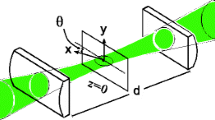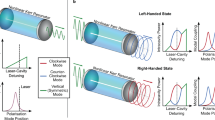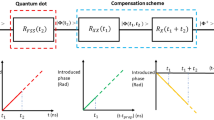Abstract
The polarization of light is utilized in many technologies throughout science and engineering. The ability to transform one state of polarization to another is a key enabling technology. Common polarization transformers are simple polarizers and polarization rotators. Simple polarizers change the intensity depending on the input state and can only output a fixed polarized state, while polarization rotators rotates the input Stokes vector in the 3D Stokes space. We experimentally demonstrate an all-optical input-agnostic polarization transformer (AI-APT), which transforms all input states of polarization to a particular state that can be polarized or partially polarized. The output state of polarization and intensity depends solely on setup parameters, and not on the input state, thereby the AI-APT functions differently from simple polarizers and polarization rotators. The AI-APT is completely passive, and thus can be used as a polarization controller or stabilizer for single photons and ultrafast pulses. To achieve this, we, for the first time, experimentally realize complete kinematic state controllability of an open single-qubit by Kraus maps put forth in Wu et al. (J Phys A 40:5681, 2007). The AI-APT may open a new frontier of partially polarized ultrafast optics.







Similar content being viewed by others
Data Availability Statement
This manuscript has no associated data or the data will not be deposited. [Authors’ comment: There are no associated data available.]
References
L.B. Wolff, Polarization-based material classification from specular reflection. IEEE Trans. Pattern Anal. Mach. Intell. 12(11), 1059–1071 (1990). https://doi.org/10.1109/34.61705
K. Koshikawa, Y. Shirai, A model-based recognition of glossy objects using their polarimetrical properties. Adv. Robot. 2(2), 137–147 (1987). https://doi.org/10.1163/156855387X00129
J.S. Tyo, D.L. Goldstein, D.B. Chenault, J.A. Shaw, Review of passive imaging polarimetry for remote sensing applications. Appl. Opt. 45(22), 5453–5469 (2006). https://doi.org/10.1364/AO.45.005453
J.R. Schott, Fundamentals of Polarimetric Remote Sensing. SPIE, 1000 20th Street, Bellingham, WA 98227-0010 USA (2009). https://doi.org/10.1117/3.817304
N. Ghosh, A.I. Vitkin, Tissue polarimetry: concepts, challenges, applications, and outlook. J. Biomed. Opt. 16(11), 110801 (2011). https://doi.org/10.1117/1.3652896
W.H.T. Vlemmings, A review of maser polarization and magnetic fields. Proc. Int. Astron. Union 3(S242), 37–46 (2007). https://doi.org/10.1017/S1743921307012549
E.L. Degl’innocenti, M. Landolfi (eds.), Polarization in Spectral Lines. Astrophysics and Space Science Library (Springer, Dordrecht, 2004). https://doi.org/10.1007/1-4020-2415-0_11
J. Zhang, S. Ding, A. Dang, Polarization property changes of optical beam transmission in atmospheric turbulent channels. Appl. Opt. 56(18), 5145–5155 (2017). https://doi.org/10.1364/AO.56.005145
J. Ma, J. Wu, L. Tan, S. Yu, Polarization properties of gaussian-schell model beams propagating in a space-to-ground optical communication downlink. Appl. Opt. 56(6), 1781–1787 (2017). https://doi.org/10.1364/AO.56.001781
R. Yang, Y. Xue, Y. Li, L. Shi, Y. Zhu, Q. Zhu, Influence of atmospheric turbulence on the quantum polarization state. In Young Scientists Forum 2017, vol. 10710 (SPIE, 1000 20th Street, Bellingham, WA 98227-0010 USA, 2018). pp. 36–41. https://doi.org/10.1117/12.2312038
S. Gasparoni, J.-W. Pan, P. Walther, T. Rudolph, A. Zeilinger, Realization of a photonic controlled-NOT gate sufficient for quantum computation. Phys. Rev. Lett. 93(2), 020504 (2004). https://doi.org/10.1103/PhysRevLett.93.020504
P. Kok, W.J. Munro, K. Nemoto, T.C. Ralph, J.P. Dowling, G.J. Milburn, Linear optical quantum computing with photonic qubits. Rev. Mod. Phys. 79(1), 135–174 (2007). https://doi.org/10.1103/RevModPhys.79.135
J.L. O’Brien, A. Furusawa, J. Vučković, Photonic quantum technologies. Nat. Photonics 3(12), 687–695 (2009). https://doi.org/10.1038/nphoton.2009.229
K.H. Kagalwala, G. Di Giuseppe, A.F. Abouraddy, B.E.A. Saleh, Single-photon three-qubit quantum logic using spatial light modulators. Nat. Commun. 8(1), 739 (2017). https://doi.org/10.1038/s41467-017-00580-x
R.K. Saripalli, A. Ghosh, N. Apurv Chaitanya, G.K. Samanta, Frequency-conversion of vector vortex beams with space-variant polarization in single-pass geometry. Appl. Phys. Lett. 115(5), 051101 (2019). https://doi.org/10.1063/1.5111593
K.M. Dorney, L. Rego, N.J. Brooks, J. San Román, C.-T. Liao, J.L. Ellis, D. Zusin, C. Gentry, Q.L. Nguyen, J.M. Shaw, A. Picón, L. Plaja, H.C. Kapteyn, M.M. Murnane, C. Hernández-García, Controlling the polarization and vortex charge of attosecond high-harmonic beams via simultaneous spin-orbit momentum conservation. Nat. Photonics 13(2), 123–130 (2019). https://doi.org/10.1038/s41566-018-0304-3
B. Alonso, I. Lopez-Quintas, W. Holgado, R. Drevinskas, P.G. Kazansky, C. Hernández-García, Í.J. Sola, Complete spatiotemporal and polarization characterization of ultrafast vector beams. Commun. Phys. 3(1), 1–10 (2020). https://doi.org/10.1038/s42005-020-00419-w
M. Banning, Practical methods of making and using multilayer filters. JOSA 37(10), 792–797 (1947). https://doi.org/10.1364/JOSA.37.000792
F.J. Duarte, Tunable Laser Optics (CRC Press, Boca Raton, Florida, 2015)
A.H. Dorrah, N.A. Rubin, A. Zaidi, M. Tamagnone, F. Capasso, Metasurface optics for on-demand polarization transformations along the optical path. Nat. Photonics (2021). https://doi.org/10.1038/s41566-020-00750-2
S. Wang, Z.-L. Deng, Y. Wang, Q. Zhou, X. Wang, Y. Cao, B.-O. Guan, S. Xiao, X. Li, Arbitrary polarization conversion dichroism metasurfaces for all-in-one full Poincaré sphere polarizers. Light Sci. Appl. 10(1), 24 (2021). https://doi.org/10.1038/s41377-021-00468-y
B. Koch, R. Noé, D. Sandel, V. Mirvoda, Versatile endless optical polarization controller/tracker/demultiplexer. Opt. Express 22(7), 8259 (2014). https://doi.org/10.1364/OE.22.008259
T. Chiba, Y. Ohtera, S. Kawakami, Polarization stabilizer using liquid crystal rotatable waveplates. J. Light. Technol. 17(5), 885–890 (1999). https://doi.org/10.1109/50.762907
M. Martinelli, P. Martelli, S.M. Pietralunga, Polarization stabilization in optical communications systems. J. Light. Technol. 24(11), 4172–4183 (2006). https://doi.org/10.1109/JLT.2006.884228
G. Millot, S. Wabnitz, Nonlinear polarization effects in optical fibers: polarization attraction and modulation instability [Invited]. J. Opt. Soc. Am. B 31(11), 2754 (2014). https://doi.org/10.1364/JOSAB.31.002754
J. Fatome, S. Pitois, P. Morin, E. Assémat, D. Sugny, A. Picozzi, H.R. Jauslin, G. Millot, V.V. Kozlov, S. Wabnitz, A universal optical all-fiber omnipolarizer. Sci. Rep. 2(1), 938 (2012). https://doi.org/10.1038/srep00938
C. Bourassin-Bouchet, L. Barreau, V. Gruson, J.-F. Hergott, F. Quéré, P. Salières, T. Ruchon, Quantifying decoherence in attosecond metrology. Phys. Rev. X 10(3), 031048 (2020). https://doi.org/10.1103/PhysRevX.10.031048
J.S. Eismann, L.H. Nicholls, D.J. Roth, M.A. Alonso, P. Banzer, F.J. Rodríguez-Fortuño, A.V. Zayats, F. Nori, K.Y. Bliokh, Transverse spinning of unpolarized light. Nat. Photonics 15(2), 156–161 (2021). https://doi.org/10.1038/s41566-020-00733-3
K. Kraus, States, Effects, and Operations Fundamental Notions of Quantum Theory. Lecture Notes in Physics (Springer, Berlin, Heidelberg, 1983)
R. Wu, A. Pechen, C. Brif, H. Rabitz, Controllability of open quantum systems with Kraus-map dynamics. J. Phys. A Math. Theor. 40(21), 5681–5693 (2007). https://doi.org/10.1088/1751-8113/40/21/015
M. Ziman, P. Štelmachovič, V. Bužek, M. Hillery, V. Scarani, N. Gisin, Diluting quantum information: an analysis of information transfer in system-reservoir interactions. Phys. Rev. A 65(4), 042105 (2002). https://doi.org/10.1103/PhysRevA.65.042105
L. Roa, A. Delgado, M.L. Ladron de Guevara, A.B. Klimov, Measurement-driven quantum evolution. Phys. Rev. A 73(1), 012322 (2006). https://doi.org/10.1103/PhysRevA.73.012322
G.G. Stokes, On the composition and resolution of streams of polarized light from different sources. Cambridge library collection - mathematics, vol. 3 (Cambridge University Press, Cambridge, 2009), pp. 233–258. https://doi.org/10.1017/CBO9780511702266.010
M. Born, E. Wolf, Principles of Optics: Electromagnetic Theory of Propagation. Interference and Diffraction of Light (Cambridge University Press, Cambridge, 1999). https://doi.org/10.1017/CBO9781139644181
J.W. Goodman, Statistical Optics (Wiley, New York, 2000)
R.C. Jones, A New calculus for the treatment of optical systemsI. Description and discussion of the calculus. JOSA 31(7), 488–493 (1941). https://doi.org/10.1364/JOSA.31.000488
D.L. Falkoff, J.E. MacDonald, On the stokes parameters for polarized radiation*. J. Opt. Soc. Am. 41(11), 861 (1951). https://doi.org/10.1364/JOSA.41.000861
U. Fano, A stokes-parameter technique for the treatment of polarization in quantum mechanics. Phys. Rev. 93(1), 121–123 (1954). https://doi.org/10.1103/PhysRev.93.121
G.B. Parrent, P. Roman, On the matrix formulation of the theory of partial polarization in terms of observables. Il Nuovo Cimento (1955-1965) 15(3), 370 (2008). https://doi.org/10.1007/BF02902573
M.A. Nielsen, I.L. Chuang, Quantum Computation and Quantum Information: 10th Anniversary (Cambridge University Press, Cambridge, 2010). https://doi.org/10.1017/CBO9780511976667
R. Simon, N. Mukunda, Universal SU(2) gadget for polarization optics. Phys. Lett. A 138(9), 474–480 (1989). https://doi.org/10.1016/0375-9601(89)90748-2
R. Simon, N. Mukunda, Minimal three-component SU(2) gadget for polarization optics. Phys. Lett. A 143(4), 165–169 (1990). https://doi.org/10.1016/0375-9601(90)90732-4
M.P. Almeida, F. de Melo, M. Hor-Meyll, A. Salles, S.P. Walborn, P.H.S. Ribeiro, L. Davidovich, Environment-induced sudden death of entanglement. Science 316(5824), 579–582 (2007). https://doi.org/10.1126/science.1139892
Y. Yugra, C. Montenegro, F. De Zela, Constraints between concurrence and polarization for mixed states subjected to open system dynamics. Phys. Rev. A 105(6), 063710 (2022). https://doi.org/10.1103/PhysRevA.105.063710
S.P. Walborn, P.H. Souto Ribeiro, L. Davidovich, F. Mintert, A. Buchleitner, Experimental determination of entanglement with a single measurement. Nature 440(7087), 1022–1024 (2006). https://doi.org/10.1038/nature04627
A. Aiello, G. Puentes, J.P. Woerdman, Linear optics and quantum maps. Phys. Rev. A 76(3), 032323 (2007). https://doi.org/10.1103/PhysRevA.76.032323
D. Barberena, G. Gatti, F. De Zela, Experimental demonstration of a secondary source of partially polarized states. J. Opt. Soc. Am. A 32(4), 697 (2015). https://doi.org/10.1364/JOSAA.32.000697
A. Lizana, I. Estévez, F.A. Torres-Ruiz, A. Peinado, C. Ramirez, J. Campos, Arbitrary state of polarization with customized degree of polarization generator. Opt. Lett. 40(16), 3790 (2015). https://doi.org/10.1364/OL.40.003790
K.A. Kirkpatrick, The Schrödinger-HJW Theorem. Found. Phys. Lett. 19(1), 95–102 (2006). https://doi.org/10.1007/s10702-006-1852-1
N. Kikuchi, Analysis of signal degree of polarization degradation used as control signal for optical polarization mode dispersion compensation. J. Light. Technol. 19(4), 480 (2001)
D.C. Louie, J. Phillips, L. Tchvialeva, S. Kalia, H. Lui, W. Wang, T.K. Lee, Degree of optical polarization as a tool for detecting melanoma: proof of principle. J. Biomed. Opt. 23(12), 1–7 (2018). https://doi.org/10.1117/1.JBO.23.12.125004
E. Pisanty, G.J. Machado, V. Vicuña-Hernández, A. Picón, A. Celi, J.P. Torres, M. Lewenstein, Knotting fractional-order knots with the polarization state of light. Nat. Photonics 13(8), 569–574 (2019). https://doi.org/10.1038/s41566-019-0450-2
L. Rego, K.M. Dorney, N.J. Brooks, Q.L. Nguyen, C.-T. Liao, J. San Román, D.E. Couch, A. Liu, E. Pisanty, M. Lewenstein, L. Plaja, H.C. Kapteyn, M.M. Murnane, C. Hernández-García, Generation of extreme-ultraviolet beams with time-varying orbital angular momentum. Science 364(6447), 9486 (2019). https://doi.org/10.1126/science.aaw9486
Acknowledgements
This work was supported by the Defense Advanced Research Projects Agency (DARPA) Grant Number D19AP00043 under mentorship of Dr. Joseph Altepeter. J.M.L. is supported by the Louisiana Board of Regents’ Graduate Fellowship Program. R.T.G. also acknowledges funding from the U.S. Office of Naval Research (ONR) under Grant N000141912374. D.I.B. is also supported by the U.S. Army Research Office (ARO) under Grant W911NF-19-1-0377. The views and conclusions contained in this document are those of the authors and should not be interpreted as representing the official policies, either expressed or implied, of DARPA, ONR, ARO, or the U.S. Government. The U.S. Government is authorized to reproduce and distribute reprints for Government purposes notwithstanding any copyright notation herein. The authors thank a Quantum editor for valuable discussion.
Author information
Authors and Affiliations
Corresponding authors
Ethics declarations
Conflict of interest
The authors declare no conflicts of interest.
Rights and permissions
Springer Nature or its licensor holds exclusive rights to this article under a publishing agreement with the author(s) or other rightsholder(s); author self-archiving of the accepted manuscript version of this article is solely governed by the terms of such publishing agreement and applicable law.
About this article
Cite this article
Zhang, W., Saripalli, R., Leamer, J. et al. All-optical input-agnostic polarization transformer via experimental Kraus-map control. Eur. Phys. J. Plus 137, 930 (2022). https://doi.org/10.1140/epjp/s13360-022-03104-9
Received:
Accepted:
Published:
DOI: https://doi.org/10.1140/epjp/s13360-022-03104-9




